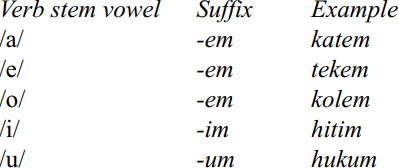


 Grammar
Grammar
 Tenses
Tenses
 Present
Present
 Past
Past
 Future
Future
 Parts Of Speech
Parts Of Speech
 Nouns
Nouns
 Verbs
Verbs
 Adverbs
Adverbs
 Adjectives
Adjectives
 Pronouns
Pronouns
 Pre Position
Pre Position
 Preposition by function
Preposition by function 
 Preposition by construction
Preposition by construction
 Conjunctions
Conjunctions
 Interjections
Interjections
 Grammar Rules
Grammar Rules
 Linguistics
Linguistics
 Semantics
Semantics
 Pragmatics
Pragmatics
 Reading Comprehension
Reading Comprehension|
Read More
Date: 2024-02-21
Date: 2023-09-15
Date: 2024-04-02
|
As described on the morphology and syntax of Solomon Islands Pijin, Pijin transitive verbs are marked with a suffix -Vm, variously -em, -im or -um. As with insertion of paragogic vowels, the vowel in -Vm is selected with respect to rules of vowel harmony. The specific rules of harmony can again vary from one speaker to the next. One possible system is the one illustrated below, where roots containing mid and low vowels take -em as a suffix, but roots with high vowels will take the identical high vowel in the suffix,- im or -um.

Thus, while kat-, tek- and kol- become katem, tekem and kolem, /huk/ ‘to hook’ becomes /hukum/ ‘to hook something’ and /hit/ ‘to hit’ becomes /hitim/ ‘to hit someone’.
However, /baet/ ‘to bite’ becomes /baetim/ for some speakers and /baetem/ for others. Further, some streamlining common in the speech of young urban Pijin speakers may shorten the -Vm to /m/. Thus ansam ‘to give an answer’ instead of ansar-em, kalam ‘to colour something’ instead of kalar-em, etc.
There are more exceptions. While -em seems to function as the default suffix, - im appears more likely in neologisms such as fotokopim ‘to photocopy something’ and faksim ‘to fax something’. Nevertheless, it appears that -em is always a possible realization of the transitive suffix. In this respect again, /e/ is the underspecified vowel.
While the variation in the realization of the vowel in the transitivizing suffix is quite large, vowel harmony nevertheless determines the insertion of the vowel into the suffix whose vowel is underspecified for height or frontness. The quality of the vowels added to the stem is determined by the stem. This applies for epenthesis, paragogue and suffixation of the transitive marker.
|
|
|
|
دخلت غرفة فنسيت ماذا تريد من داخلها.. خبير يفسر الحالة
|
|
|
|
|
|
|
ثورة طبية.. ابتكار أصغر جهاز لتنظيم ضربات القلب في العالم
|
|
|
|
|
|
|
قسم شؤون المعارف ووفد من جامعة البصرة يبحثان سبل تعزيز التعاون المشترك
|
|
|